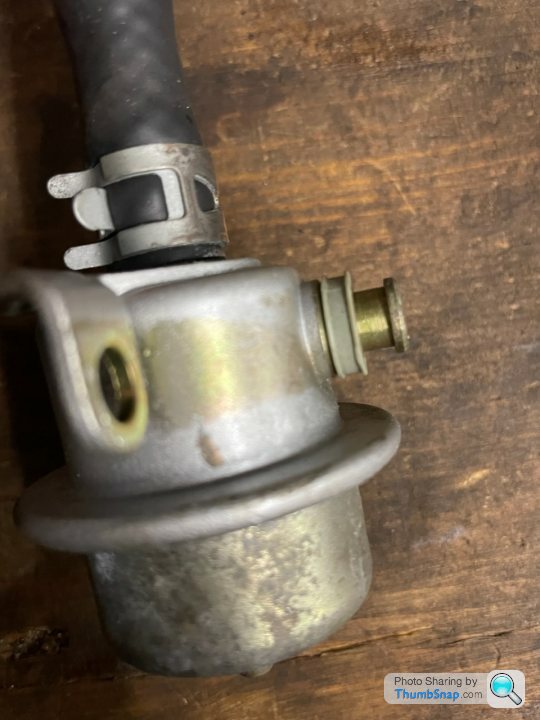Discussion
I am just in the middle of replacing my hoses on a preventative basis, the old one’s actually look ok, I have done the ones around the pump and fitted a new filter, but the ones at the front look a real pain to access, the return line maybe accessible from below but the pressure line definitely needs the plenum removing at least, is there any reason I should not shorten the front of both copper pipes so that in the future this job is a nice and easy one that can be done from below, or even go full flexy hose from back to front on both sides ???
I experienced several fuel leaks at the junction of copper and flexible fuel hoses so replaced all the copper with flexi.
That was in 2015 and no problems since. You can eliminate several copper/flexi and steel/flexi junctions and thus minmise the chance of leaks.
See: http://www.bertram-hill.com/replacing-the-fuel-lin...
That was in 2015 and no problems since. You can eliminate several copper/flexi and steel/flexi junctions and thus minmise the chance of leaks.
See: http://www.bertram-hill.com/replacing-the-fuel-lin...
You can't really just throw Flexi down the back of the engine, you'll have to clip it somewhere back there to support it and then you'll have the same problem accessing the clips when you want to change it again.
If you're going to the effort of changing it for future ease then swap it for copper pipe that reaches all the way to the top, more loose Flexi hose feeding down the back of the engine can't be an improvement (in my opinion of course)
If you're going to the effort of changing it for future ease then swap it for copper pipe that reaches all the way to the top, more loose Flexi hose feeding down the back of the engine can't be an improvement (in my opinion of course)
s p a c e m a n said:
You can't really just throw Flexi down the back of the engine, you'll have to clip it somewhere back there to support it and then you'll have the same problem accessing the clips when you want to change it again.
If you're going to the effort of changing it for future ease then swap it for copper pipe that reaches all the way to the top, more loose Flexi hose feeding down the back of the engine can't be an improvement (in my opinion of course)
This ^^^^^^ If you're going to the effort of changing it for future ease then swap it for copper pipe that reaches all the way to the top, more loose Flexi hose feeding down the back of the engine can't be an improvement (in my opinion of course)
Having replaced my copper pipes and extending them up to top of bulkhead / engine bay when doing a body off it occurs to me on a ramp it’s really quite easy to replace these old copper pipes even with body on.
You will have to reach up above gearbox to feed them up which is awkward but it can be done.
I’m sure someone like Powers could do it in a few hrs.
If doing it yourself remove old pipes carefully so you can use them as a pattern to shape new pipes.
Clearly you also would need to get a tape measure or bit of rope and taking from the end of old pipe feed and observe what curves you need to create the correct shape and length to get your new longer copper pipes to reach where you want them, namely the engine bay.
I’m of the mind the less rubber pipe you use the better long term it will be. Going by my original old pipes the new ones will last decades if looked after. An engine oil leak or two helps

s p a c e m a n said:
You can't really just throw Flexi down the back of the engine, you'll have to clip it somewhere back there to support it and then you'll have the same problem accessing the clips when you want to change it again.
If you're going to the effort of changing it for future ease then swap it for copper pipe that reaches all the way to the top, more loose Flexi hose feeding down the back of the engine can't be an improvement (in my opinion of course)
Of course the flexi was clipped behind the engine.If you're going to the effort of changing it for future ease then swap it for copper pipe that reaches all the way to the top, more loose Flexi hose feeding down the back of the engine can't be an improvement (in my opinion of course)
Access is no problem, I have a 4 post lift!
I have had numerous fuel leaks where the original flexi joined the copper tube, since replacement none.
Having to replaced the fuel lines twice in the engine compartment, they leaked around the 90 degree curve to the fuel rail on the inside of the curve. First set were 12 year old originals, and the second set what was supposed to be upgraded braded. Now they are plan again - but I added this to the supply line (there are different sizes) to helpfully take some of the stress out. If replumbing with copper, would be good to keep the engine bay flexi bits straight if poss to avoid the stress of the tight curve. Talking the plenium off was far easier that trying to do it attached! Also bought a really long flexible spring type of hose clip tool so only one hand needs to be stuffed down there
https://www.carbuilder.com/uk/former-for-134mm-od-...
https://www.carbuilder.com/uk/former-for-134mm-od-...
I hadn’t seen these before but they look to be a good idea, I don’t recall my bends being particularly tight though, I will check on refitting them, I was surprised though at my old ones looking very good still when I removed them although they have certainly been on there for more than the 8 years I have had the car.
I have a new hose in place at the pressure side, it wasn’t as bad as I thought it would be even without removing the plenum, but I don’t have the clamp on it yet so we will see, the return one I think I will shorten the copper a little bit to make it fairly easy to do from below
I have a new hose in place at the pressure side, it wasn’t as bad as I thought it would be even without removing the plenum, but I don’t have the clamp on it yet so we will see, the return one I think I will shorten the copper a little bit to make it fairly easy to do from below
A bump of this thread to remind people of the importance of doing this.
My car's been off the road for a short period while awaiting to do a few jobs. On test firing the car I had a significant fuel leak to deal with. The pump to fuel filter hose is pictured below.


I don't know if this was a rodent's supper or simply the old pipe breaking down from the inside out and the high pressure blowing the outer skin out but I'm glad I discovered it in a risk free environment and I've no replaced all the rubber in the tank to fuel rail and return. This was the only damaged piece but it had all lost it's flexibility. I took it as a good time to replace the jubilee clips for proper fuel hose clips too.
I don't know if exhaust temperatures get hot enough to ignite petrol or not but I count myself lucky that my car was on a ramp and not on a journey with me blissfully unaware.
My car's been off the road for a short period while awaiting to do a few jobs. On test firing the car I had a significant fuel leak to deal with. The pump to fuel filter hose is pictured below.


I don't know if this was a rodent's supper or simply the old pipe breaking down from the inside out and the high pressure blowing the outer skin out but I'm glad I discovered it in a risk free environment and I've no replaced all the rubber in the tank to fuel rail and return. This was the only damaged piece but it had all lost it's flexibility. I took it as a good time to replace the jubilee clips for proper fuel hose clips too.
I don't know if exhaust temperatures get hot enough to ignite petrol or not but I count myself lucky that my car was on a ramp and not on a journey with me blissfully unaware.
indigochim said:
I don't know if exhaust temperatures get hot enough to ignite petrol
Petrol requires a 'spark' to ignite. Simply being 'hot' leads to evapouration. I recall a video of petrol being sprayed on the hot manifold of a running engine to demonstrate the point. Them were the days!Gassing Station | Chimaera | Top of Page | What's New | My Stuff




